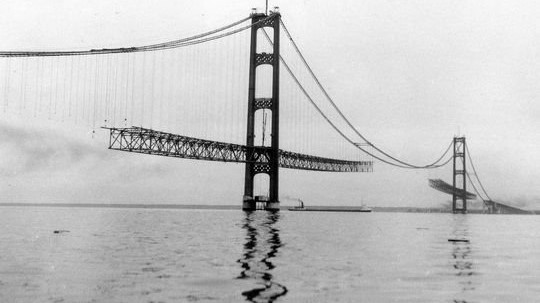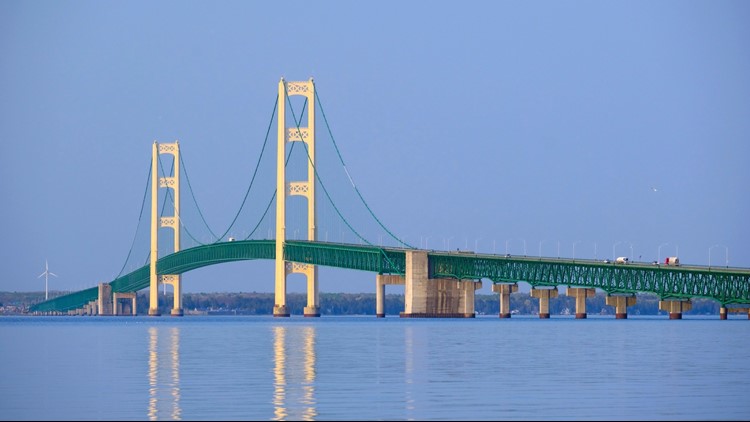Michigan's two peninsulas became truly connected 60 years ago this week, as the Mackinac Bridge opened to traffic on Nov. 1, 1957.
The Mighty Mac remains mighty to this day.
"From a civil engineering perspective, it is the crown jewel of our state, without question," said Ronald Brenke, executive director of the American Society of Civil Engineers' Michigan Chapter.
Two of Michigan's standard automobile license plates feature images of the Mackinac Bridge, an instantly identifiable state symbol. It was the longest suspension bridge in the world at the time it was built, at 5 miles, and remains the longest in the Western Hemisphere today.
"It's an icon in the state; something that we're all very proud of," Brenke said.
The Mighty Mac is clearly going strong. But man-made things don't last forever. So, how much life does the Mackinac Bridge have left in it?

The Mackinac Bridge has many more generations of peninsula-switching motorists to facilitate, according to the man in charge of it. But in the coming decades, the bridge will get some of the first major work it has seen since it was built.
Bridges age differently than other major infrastructure; different components have different service lives, said Robert Sweeney, executive secretary and chief executive officer of the Mackinac Bridge Authority, an independent state agency that operates and maintains the bridge.
The bridge's two large towers — 552 feet above water; up to 142 feet into the waters of the Straits of Mackinac, where lakes Michigan and Huron meet, and down into the lake bottom up to another 105 feet — are in remarkably great shape, Sweeney said.
"The piers themselves are in mint condition; pretty much the same as when they were put down," he said.
The Mackinac Bridge used 931,000 tons of concrete in construction.
"With concrete in cool water, it cures over a long period of time, and it really builds up the strength," Sweeney said.
Scour, an engineering term for water body currents eroding away the foundations of a bridge and negatively affecting its structural soundness, is not an issue at the Mackinac Bridge, despite six decades of dynamic, shifting water currents in the Straits of Mackinac working against it, Sweeney said.
"If there's any scour, there's less than a foot of scour," he said.
The authority operates as a 50-employee bridge maintenance team that keeps it painted and repaired, Sweeney said.
"Most of the work we've done is what I'd call preservation work, just extending the life," he said.
That's paid off on the bridge's deck, the suspended steel portion upon which vehicles drive. A typical steel deck lasts 40 years, and the Mackinac Bridge's is at 60 years going strong.
But that deck will become the first major rehabilitation work on the bridge in its history. The bridge authority is targeting 2024 as the start of a three-year project to remove all of the deck — both the steel-grate portion in the center lanes and the asphalt-covered outside lines — and replace all of the 1,500 cross beams in the bridge's suspended span, which run horizontally every 5 feet. The project is expected to also include replacement of the five long "stringer" I-beams that run the length of the bridge roadway below the cross-beams.

The work is estimated to cost $94 million in future dollars.
"This will be our biggest project, for sure," Sweeney said.
Then, beginning around 2031, the bridge authority is planning to replace the deck or roadway on the bridge's approach spans, the portions of the bridge before the suspended center, on both the north and south sides. That process is expected to take five years and cost $147 million in future dollars, Sweeney said.
On both projects, traffic will continue with lane closures, he said.
A baby compared to Brooklyn
Think long-standing suspension bridges in the U.S., and the Brooklyn Bridge is the highest-profile old-timer.
Connecting the New York City boroughs of Brooklyn and Manhattan over the East River, work was completed on the nearly 6,000-foot Brooklyn Bridge in 1883 — almost four decades before automobiles became common.
"The most significant updates to the bridge have been to the roadway and to the cabling — even the cabling hasn't been major," said Julia Golia, director of public history at the Brooklyn Historical Society.
The New York City Department of Transportation is planning more significant work to the bridge's towers, substructure, foot walks, main and suspender cables, and bridge steel structure beginning in 2019 and likely continuing through 2033.

Paying for it yourself helps
It's no secret why, as highways, overpasses and sewer and water pipes crumble, the 60-year-old Mackinac Bridge continues to gleam, Brenke said. It's the bridge authority's ability to determine its maintenance and other costs and set bridge fares to cover them.
The more than 4 million motorists who crossed the Mackinac Bridge last year generated more than $22.7 million in revenue.
"It's got a nice, dedicated source of funding," Brenke said. "The bridge is tolled, and (Sweeney) and his people do a great job of forward thinking about how much money they are going to need, their scheduled maintenance, and then adjust bridge fares based on expenses.
"I wish every piece of infrastructure in Michigan could have that sort of system where, when they need to repair something, they have the money available to do it."
The bridge's ultimate fate might have more to do with becoming too outmoded for transportation a century or so from now, Sweeney said. The bridge already has its aspects that don't meet current standards.
"Our maintenance vehicles currently have to block at least a lane of traffic every time they are doing work on the bridge," he said. "If you were building the bridge now, you would have a 10-foot shoulder along it; not a 3-foot catwalk."
The center lanes of the suspended portion of the bridge, at 11 feet wide, are also out of standard, which is now 12 feet, Sweeney said.
Bridges are very resilient, and one as well-maintained as the Mackinac Bridge especially so, Brenke said.
"The Mackinac Bridge, if it's maintained and taken care of, it could last virtually forever," he said.
"It's going to be around a long, long time."
►Make it easy to keep up to date with more stories like this. Download the WZZM 13 app now.
Have a news tip? Email news@wzzm13.com, visit our Facebook page or Twitter.



